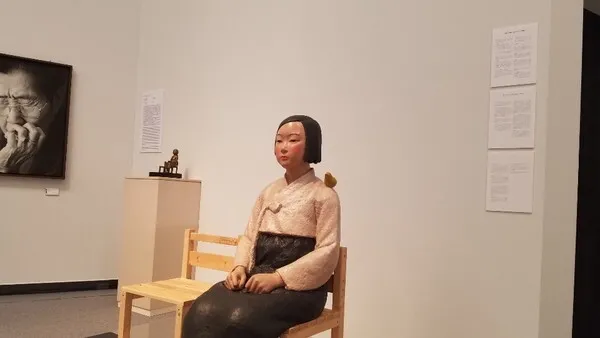hankyoreh
Links to other country sites 다른 나라 사이트 링크
Comfort woman exhibit attracts 13,298 applicants in just six days

The Aichi Triennale, which included the exhibition of a “Statue of a Girl of Peace,” which represents comfort women victims, has come to a close– leaving behind unanswered questions about attitudes toward history and freedom of expression in Japan.
Japan’s biggest international art festival, the Aichi Triennale finished on Oct. 14 after 75 days. At over 650,000, the total number of visitors was the highest ever. In terms of number of visits, it was a success. But the event also encountered difficulties when a feature exhibition titled “After ‘Freedom of Expression?,’” which included the comfort woman statue, was suspended in response to right-wing intimidation tactics and protest calls, with its reopening finally coming just as the festival was set to finish. Not counting days when the venue was closed, the feature exhibition was actually open for just six days after its reopening, during which time it was viewed by 1,133 people chosen by lottery from among 13,298 contestants. According to the Mainichi Shimbun newspaper, 3,166 people took part in the drawing on the closing date of Oct. 14.
The showing of the comfort woman statue attracted major attention from the time the triennial opened on Aug. 1. Not only are statues of comfort women seen as a major taboo in Japan, but it was also the first time one was being shown in complete form at a public art museum in Japan. Some of the Japanese visitors at the venue sat down next to the statue and looked into its eyes. But right-wingers launched a systematic protest campaign with protest faxes, emails, and a form of “telephone bombing” known locally as “dentotsu.”
The messages went beyond mere protests to include threats of “going to the venue with a gasoline canister,” and Aichi Prefecture finally announced the exhibition’s suspension on Aug. 3, just three days after it had begun. Members of the “After ‘Freedom of Expression?’” executive committee continued to demand that the prefecture reopen it, and after they filed an injunction in court ordering its resumption, the exhibit was finally resumed on Oct. 3, a week ahead of the festival’s closing date. At the same time, the prefecture imposed various constraints, citing security issues. Entrance was permitted only to visitors drawn by lottery, who were required to present identification and undergo metal detector searches before going inside.
Aichi Prefecture Gov. Hideaki Omura said on Oct. 14 that the “frustrations in Japan today were on vivid display.” Daisuke Tsuda, the triennial’s artistic director, said that freedom of expression was “recovered to some extent” through the exhibition’s reopening.
The suspension of “After ‘Freedom of Expression?’” was also a source of some controversy within Japan. But the debate was focused on guarantees on freedom of expression, with little discussion of the issues concerning wartime sexual assault and historical perceptions that the statue was intended to raise.
“The starting point for this exhibition was the issue of erasure of expression by social minorities in terms of the exclusionism, gender discrimination, and denial of responsibility for colonialism in Japanese society,” explained Yuka Okamoto, a member of the “After ‘Freedom of Expression?’” executive committee.
“But Aichi Prefecture did not mention anything about matters of historical attitudes. It’s fortunate that the exhibition was opened, but I have mixed feelings about it,” she added.
Nagoya Mayor Takeshi Kawamura, who previously referred to the comfort woman statue exhibition as “trampling on the hearts of the Japanese,” hinted on Oct. 15 that his city might not pay its portion of costs for the triennial’s staging.
By Cho Ki-weon, Tokyo correspondent
Please direct comments or questions to [english@hani.co.kr]

Editorial・opinion
![[Column] Imperial tyranny, Korean humiliation [Column] Imperial tyranny, Korean humiliation](https://flexible.img.hani.co.kr/flexible/normal/500/300/imgdb/original/2025/0912/7617576652278449.jpg) [Column] Imperial tyranny, Korean humiliation
[Column] Imperial tyranny, Korean humiliation![[Correspondent’s column] Cognitive dissonance in MAGA world [Correspondent’s column] Cognitive dissonance in MAGA world](https://flexible.img.hani.co.kr/flexible/normal/500/300/imgdb/original/2025/0912/3417576648512186.jpg) [Correspondent’s column] Cognitive dissonance in MAGA world
[Correspondent’s column] Cognitive dissonance in MAGA world- [Editorial] Korea, US need a ‘gentlemen’s agreement’ on what job creation entails
- [Column] Why MAGA has its eyes set on Korea
- [Column] Lee still has his work cut out for him after summit with Trump
- [Editorial] Is this any way for the US to treat an ally?
- [Column] Lee’s difficult task of striking a balance on Japan
- [Editorial] Multipolar era means Seoul must broaden its diplomacy
- [Column] North and South Korea are no longer pawns in US-China-Russia relations
- [Column] Who we fail when we oversimplify the ‘comfort women’ issue
Most viewed articles
- 1Seoul says US must fix its visa system if it wants Korea’s investments
- 2North Korea said to have exposed numerous US spies after botched 2019 SEAL mission
- 3Freed workers arrive in Korea, one week after ICE raid in Georgia
- 4[Column] Imperial tyranny, Korean humiliation
- 5[Column] Why MAGA has its eyes set on Korea
- 6MAGA’s traveling circus comes to Korea
- 7Korea’s president says firms will be ‘very hesitant’ about investing in US after ICE raid
- 8[Correspondent’s column] Cognitive dissonance in MAGA world
- 9Lee says he won’t sign any tariff deal with US that doesn’t benefit Korea
- 10Son of ex-President Roh Tae-woo tapped to serve as ambassador to China